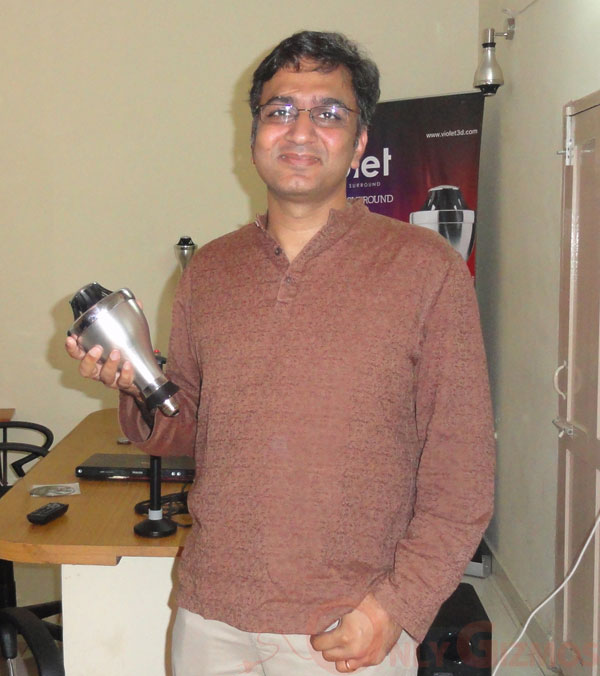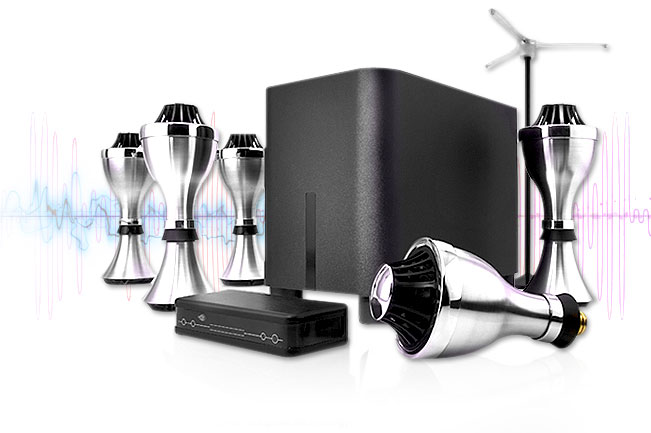We went to NasscomPC 2011 with a quest to find if successful hardware manufacturing startups can be possible in the Indian sphere. Though the scenario of such an event happening looks bleak with consistent domination of China and the failure of the likes of Infibeam and Notion Ink, we were hopeful.

And then we heard of Ashish Aggarwal and Snap Networks, a startup from Bangalore, India which manufactures a home theater system named Violet 3D and even more interestingly their products had no involvement of China in it. This was surprising for the simple fact that even an organization as successful as Apple also relies on China for the manufacturing of its devices like the iPod, iPhone and the iPad’s.
We caught up with Ashish at his office in Bangalore. This interesting and revolutionary journey about Snap Network is a bit detailed, so before you go ahead we would like you to grab hold of your favorite weekend cuppa.
The Start:
Ashish Aggarwal has a PhD in Electrical Engineering from UC, Santa Barbara specializing in digital signal processing. He started his professional career with small firm named Portal Player, wherein he led a team of 8 people working on the algorithm and software development of the first generation iPod. Besides he also worked for Harman Kardon for five years working in different roles and left the firm in the capacity of Director Engineering at the firm.
Ashish Aggarwal is someone who loves challenges and he took up many challenging tasks in his entire career. He remembers how he dismantled his father brand new VHS player, promising to fix it up but only managed to do so after a year. He started his career working on the first generation iPod players and solved many intriguing problems which included the likes of the iPod playing instantly as soon as the ‘play button’ is touched or instant play even after rewinding or forwarding a song; help increase the voice recording time on the iPod by reducing the encoding power on it.
He was always fascinated by sound and music since his teenage days. While at Harman he was very intrigued by the fact that why ‘home theater systems’ were so complicated to setup and use. It was especially the problem with sub woofers that captivated his imagination, the fact that if you move in a room fitted with a home theater system the experience you enjoy is not consistent and changes as you move about in a room.
His interest in the subject was catalyzed by his friend Shri, whom he had gifted an Infinity home theater system, though the system performed well his friend had hardly used it owing to the complexity in setting it up and the fact that home theater systems require a special acoustic room setup for optimum audio experience.
This is when Ashish had a burning desire to design such a home theater system which would not only be easy to set up but at the same time it would be free of special space requirements. And thus Ashish quit his much coveted job at Harman Kardon as a Director of Engineering in March of 2008.
The Story:
It is with this objective that Ashish Aggarwal along with three of his technocrat friends set up Snap Networks in India and registered the same in May 2008. Ashish says he knew even if they were able to create the product they would need someone who had the experience of creating a brand. After much coaxing he was able to rope in LH Bhatia as the chairman of the company, an industry veteran, who had just taken a retirement from BPL as Director of Sales and was enjoying his golf. The team was thus formed.
After small projects on networking, connectivity failed to deliver the desired results for the startup; Ashish decided to work on his dream project and thus was born, Violet 3D.
Armed with the idea of designing such a speaker that would be as easy as fitting a light bulb into a socket, Ashish Aggarwal actually ended up making one that was to be placed into a bulb socket.
But, unfortunately his co-founders disbanded soon after due to the recession that had kicked in globally during the time in 2008-2009. And all Ashish and Mr. Bhatia had, were three working prototypes that they had managed to make during the short stint on the project.
But they believed if Apple could sell iPod and iPhones based on the design and simplicity of use so could he. It’s this validation of their idea that egged them on to persist with the project and to build a new motivated team after a small round of angel investment.
The Solution:
Let us now go ahead and take a look at this revolutionary product named Violet 3D and understand what makes it industry changing.
Violet 3D is a home theater system which comes with 5 speakers, a sub-woofer, Space Sensing Microphone and would cost you Rs. 65,000.
So what makes Violet 3D so special?
Though the answer to this question has a lot of technical explanation attached to it, we will not delve much into it and explain it to you in as much layman terms as possible.
Let’s talk about the non technical aspects first which you can easily understand and besides they are actually the ones that make Violet 3D speakers really stand out from the rest in the industry.

To start off, the design of the Violet 3D makes it special. The nine pin design to the Violet 3D was given by Michael Folay who is a renowned industrial designer in the Indian space. The fact that it is so easy to install, one just has to screw it into a bulb socket to get started and to add to it the speakers are wireless and not connected to each other. This essentially frees you of the wire clutter that is usually associated with all the home theater systems.
Or in the words of Mr. Aggarwal who says that, “The design is so simple that even your grandma can put it into place, set it up and start playing the system”.

Besides the setting up of the speakers is automated and hassle free which is very unlike the other home theater systems which can be very harrowing at times with all the reading of the manuals required and so much wires required to be plugged in so much so that it sometimes takes hours for even specialists to get the system setup.
Talking about the technical aspects, Stephen J, an Acoustic Research Engineer with Snap Networks told us that the Violet 3D has very ‘high fidelity’, which in simpler terms means that the sound reproduced by the speakers is in a manner very similar to that of the source. Though, fidelity is not the only factor that makes the speakers really good to listen to.
In addition to fidelity it is important that all the speakers in a room produce sound with a proper timing so as to produce the optimum true surround sound effect and this phenomenon is called coherence. In other words, when the speakers in a room produce sound in synchronization and harmony you have coherence.
One of the other important things is that the traditional 5.1 home theater systems usually have an ideal seating position, as in if you move about in a home theater setup room; you would have a different experience of the sound at different spots in the room.
This happens because the speakers in a home theater system are unidirectional, which means that they throw sound only in a particular direction in a room, which means that you have to constantly adjust the positioning of the speakers based on your seating position in the room. And as we are never likely to remain in the same position in a room for a long time, you would have to keep changing the direction of the speakers for the optimum sound, which can be a matter of grave inconvenience for the audiophiles.
Violet 3D eliminates the same with the help of their specially designed ‘omnidirectional’ speakers. The speakers actually are not omnidirectional but they are able to change the direction of sound based on the location of the listener. This is done with the help of their magic box, which Ashish simply calls the ‘transmitter’. The transmitter coupled with the Space Sensing Microphones, calculates the size of the room and the location of the listener thus helping to automatically adjust the settings on all the individual speakers and the direction in which the speakers should throw the sound for an optimum 3D surround sound effect for the speaker even when he is moving about in the room.
In case you are still curios and want to more about the technology behind the making of the Violet 3D, we suggest you go ahead and read their white paper here.
I believe, we have said enough about the Violet 3D speakers and it’s about time we head to a video and see the real thing in action with Ashish Aggarwal explaining and taking us through the whole procedure.
As you can make out from the video, the heart of the system lies in the transmitter which was made by Ashish after putting in months of effort and research in this small lab.

We understand if it’s difficult to believe but this is the very lab where all of the R&D behind this technology took place and was put into the product. After all they had a very small budget to play around with.
 The transmitter which controls the speakers using digital processing technology is so effective that there is zero distortion in sound even at higher volumes or with higher settings of treble or bass. These transmitters are fitted with complex chips which directly contribute to the high price tag of the Violet 3D.
The transmitter which controls the speakers using digital processing technology is so effective that there is zero distortion in sound even at higher volumes or with higher settings of treble or bass. These transmitters are fitted with complex chips which directly contribute to the high price tag of the Violet 3D.

Add to it the fact that there is no disturbance whatsoever even if you have an incoming call or any other wireless activity going around in the room even if it is right next to the speakers, this is because the speakers have a metal finish which helps prevents any interference with the speakers.
In effect the Violet 3D system will give you the same experience irrespective of the type of room the system is placed in, even if the dimensions of the room are acoustically imperfect.
In case you are using the system in an open space or a much larger room, you have the option of connecting up to 21 speakers simultaneously with the system.
Summary:
Let us go ahead critically analyze the product:
Pros:
- Simple design
- Easy to set up (4 minutes max)
- Wireless speakers and sub woofer
- 3D surround sound at all places in the room
Cons:
- Lack of HDMI
Currently there is no HDMI connectivity option available in the package. Though you have the option of buying one separately, it would cost you another Rs. 12,000 which is very costly.
- Pricing of the product
Yes, the pricing of the Violet 3D can be one of the problems for the product. Today you have the standard home theatre systems for the masses priced at around Rs. 15,000-20,000 at the end of one spectrum while on the other we have the likes of luxurious international brands like Bose, JBL etc. for the audiophiles which cost one around 1.5 – 2 lakhs. And interestingly the Violet 3D will fall somewhere in between them. So the product might appeal to the masses but they might consider it too costly whereas the audiophiles might not consider it that big a brand to invest their money in buying the Violet 3D.
Mr. Aggarwal says that they would be able to reduce the pricing of the product considerably once they get into mass production thus achieving economies of scale.
Though, I believe that if Ashish Aggarwal manages to get the right sort of branding and positioning for the product, he could easily lure both the ends of the spectrum into buying the product because of the pricing of the product which is a third of the bigger players in the market.
Ashish prefers to summarize the Violet 3D in just two words which once his employee had used to describe the speakers, i.e. “Simply Good”.





